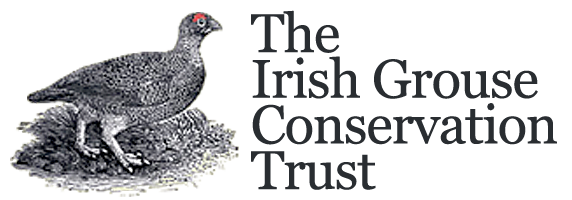Background & History
The Irish Grouse Conservation Trust was formed in 2006 with the aim of conserving the depleted grouse populations and their natural upland habitats in Ireland. The IGCT is a Registered UK Charity funded entirely by the financial assistance of its founding subscribers.
Background History of the Project Site
Glenwherry had been managed as a grouse moor up until the 1960s. Old game books kept at Glenarm Castle show hundred brace days in the late 1950s - early 1960s. The Game Keeper at Glenarm, Robert Luff, counted the Grouse at Glenwherry from 2000 to 2006. From 2000 until 2006 Grouse numbers remained constant at 4-5 pairs in the Spring counts. One of the attractions of the project site of c.7,000 acres is the fact that there is a considerable additional acreage of potentially suitable habitat in the surrounding area that could be incorporated into the project in due course. Until 2008 BASC, NIEA and RSPB ran a project on an adjoining site specifically related to breeding Waders. Vermin control had been carried out on the adjoining site for a period of five years. Antrim Estates Company, owners of the sporting rights, have leased the rights to the IGCT for the term of the project and provides management and administrative support. No vermin control had been carried out from the late 60s until the arrival of our own Keeper, Lee McManamon in 2006.
IGCT Aims
- To create a sustainable and viable Grouse Moor, while at the same time improving habitat and biodiversity for other upland species.
- To play our part in helping to resolve the longstanding hen harrier/red grouse debate on the basis of an equal partnership of all interested parties.
- To raise awareness: The IGCT aims to educate and demonstrate best practice in upland management in partnership with DARD (Greenmont Agricultural College).
- A window of opportunity exists to form partnerships with land owners, government bodies and others to improve farming practices and conservation, and help fulfil EU objectives specific to Ireland.
IGCT Achievements
The IGCT created a unique partnership in the United Kingdom context with the Department of Agriculture & Rural Development (DARD), the RSPB, the Northern Ireland Environment Agency (NIEA) and local stakeholders. This group is called the Glenwherry Heathland Regeneration Partnership, with IGCT representation from both Adrian Morrow and Lee McManaman. The GHRP meets quarterly and is in the process of finalising a Master Plan. The Master Plan aims to change current Department of Agriculture policy regarding their Countryside Management Scheme (CMS), which is currently rolled out throughout Northern Ireland on a uniform basis. The current CMS does not take into consideration habitat management practices for the regeneration of Grouse i.e. stocking densities, grazing regimes and Moorland management practices. Landowners who are not signed up to the CMS are currently exempt from any European legislation. This arrangement is anomalous and, in our view, policy needs to become more aligned and coherent. The Master Plan will be the most significant achievement to date. It is hoped this document will result in a change in government legislation, as enforced by NIEA, mainly in relation to the burning of “blanket bog” which is currently prohibited within the Countryside Management Scheme (CMS) but allowed outside the scheme. We remain confident that research over the next few years will prove beyond doubt that the burning of “blanket bog” can deliver a benefit both for heath land regeneration and wildlife. RSPB have been particularly supportive and helpful to the IGCT in negotiations with other parties over the Master Plan. The Game and Wildlife Conservation Trust (G&WCT) have followed our progress and expressed interest in exploring the possibility of partnering with us as we plan for the next five years (2012-17). The IGCT has helped to initiate implementation of the NIEA 2003 Red Grouse Action Plan. There is also strong support for the work of IGCT from local stakeholders as it will bring clarity to the current policy and may provide opportunities for further diversification of farming activities. We have been the main advisory body helping NIEA to put forward a Red Grouse Action Plan Delivery Group. This Group has made several presentations to Government Ministers to date, namely Edwin Poots (DOE) and Michelle Gildernew (DARD). The IGCT is the leading agricultural body in Northern Ireland who can help Government fulfil EU Policies for both Grouse and Raptors. If adopted, the Master Plan will be used to set policy within Northern Ireland to assist upland management. The IGCT is working successfully within an SPA (Special Protection Area) and has successfully increased Grouse numbers by 85% since inception. We have pulled together a large database of information within the project site never before collated in Northern Ireland including:
- Irish Hare survey
- Breeding Wader survey
- Raptor surveys
- Grouse counts
- Habitat/vegetation survey
- Vermin counts
One of the key objectives will be to build on the achievements of the first five years and create a model that can be exported and implemented across other upland areas.
Future Strategy for IGCT
The IGCT has achieved a considerable amount in the short time that it has been around. Relying entirely on the generosity of its founding subscribers, the Trust has successfully managed to get the first project to save the Irish Grouse underway. The success of the project at Glenwherry has attracted the attention of government bodies and will assist in their obligations to fulfil EU objectives and the case for directing resources towards investment into the management of Ireland's uplands has gathered pace.



